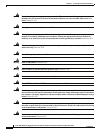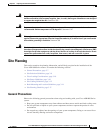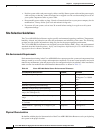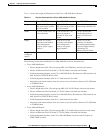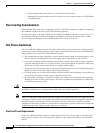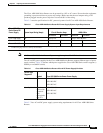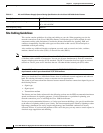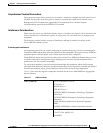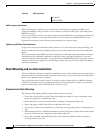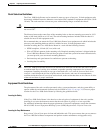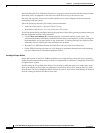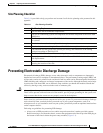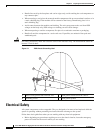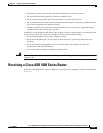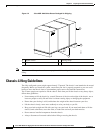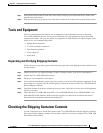
3-14
Cisco ASR 1000 Series Aggregation Services Routers Hardware Installation and Initial Configuration Guide
OL-13208-03
Chapter 3 Preparing Your Site for Installation
Site Planning
Radio Frequency Interference
When electromagnetic fields act over a long distance, radio frequency interference (RFI) can be
propagated. Building wiring can often act as an antenna, receiving the RFI signals and creating more
EMI on the wiring.
If you use twisted-pair cable in your plant wiring with a good distribution of grounding conductors, the
plant wiring is unlikely to emit radio interference. If you exceed the recommended distances, use a
high-quality twisted-pair cable with one ground conductor for each data signal.
Lightning and AC Power Fault Interference
If signal wires exceed recommended cabling distances, or if signal wires pass between buildings, you
should consider the effect that a lightning strike in your vicinity might have on the Cisco 1000 Series
Router.
The electromagnetic pulse (EMP) generated by lightning or other high-energy phenomena can couple
enough energy into unshielded conductors to damage or destroy electronic equipment. If you have
previously experienced such problems, you should consult with RFI/EMI experts to ensure that you have
adequate electrical surge suppression and shielding of signal cables in your Cisco
1000 Series Router
operating environment.
Rack-Mounting and Location Guidelines
The Cisco 1000 Series Router is designed for standalone, two-post 19 inch rack-mount, four-post 19 inch
rack-mount and closed cabinet systems with front and rear doors. You can mount the Cisco
1000 Series
Router on an equipment shelf or tabletop.
The sections that follow describe criteria for selecting a rack to mount the Cisco 1000 Series Router,
guidelines for placing the rack for reliable operation, and safety precautions to take to prevent bodily
injury when mounting a Cisco ASR1000 Series system in a rack.
Precautions for Rack-Mounting
The following rack-mount guidelines are provided to ensure your safety:
• Do not move large racks by yourself. Due to the height and weight of a rack, a minimum of two
people are required to accomplish this task.
• Ensure that the rack is level and stable before extending a component from the rack.
• Ensure that proper airflow is provided to components in the rack.
• Do not step or stand on any component or system when servicing other systems or components in a
rack.
• When mounting the Cisco 1000 Series Router in a partially filled rack, load the rack from the bottom
to the top with the heaviest component at the bottom of the rack.
• If the rack is provided with stabilizing devices, then install the stabilizers before mounting or
servicing the unit in the rack.
IEC 60950-1
AS/NZS 60950.1
Table 3-8 EMC Standards



